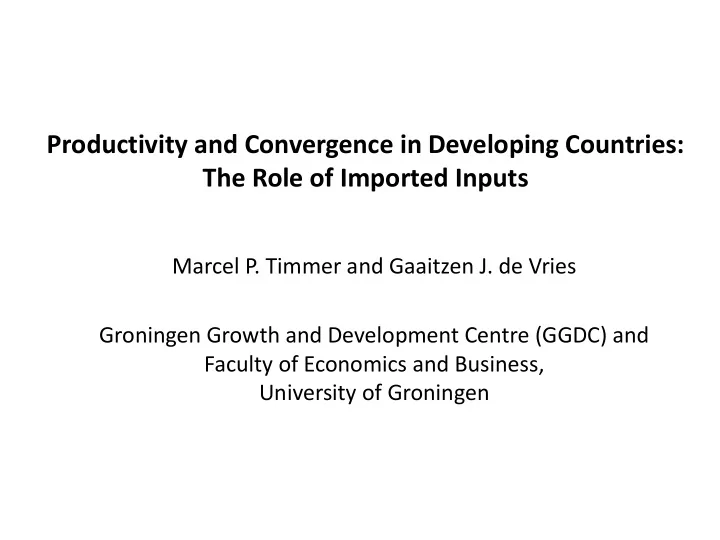

Productivity and Convergence in Developing Countries: The Role of Imported Inputs Marcel P. Timmer and Gaaitzen J. de Vries Groningen Growth and Development Centre (GGDC) and Faculty of Economics and Business, University of Groningen
Motivation • Technology transfer embodied in capital inputs from leader to follower countries is potentially an important source underlying productivity growth in developing countries (Gerschenkron, 1952; Nelson and Phelps, 1966; Abramovitz,1986; Landes, 1998) Typically firm-level studies find strong support for the effects of imported • intermediates on productivity growth (e.g. Amiti and Konings, 2007; Muendler, 2004) • …but there is weak(er) support for it in aggregate cross-country analysis (Rodriguez and Rodrik, 2000).
This paper • Examines the role of technology transfer in explaining productivity growth in developing countries Main contribution: • Sector (meso) analysis, which provides a bridge between firm-level (micro) and aggregate cross-country (macro) analysis New dataset: • 30 countries: 9 in Asia, 10 in Latin America, 11 in Sub-Saharan Africa Annual data from 1960 to 2010 • 10 broad sectors of the total economy (GGDC 10 sector database, • www.ggdc.net) • Value added, employment, sector-specific PPPs
Theoretical framework and model specification • Labor productivity ( A ijt = VA ijt /EMP ijt ) in sector j of country i may increase because of innovation or technology transfer (Acemoglu et al. 2006) Imports of intermediates and capital goods (Z ijt = IMP ijt /VA ijt ) may • influence technology transfer, which can be tested as follows
Initial distance to the frontier versus average LP growth (country-sector observations) 10 Average LP growth rate (%), 1960-2010 5 0 -5 0 1 2 3 4 5 6 Initial distance to frontier (1960)
Main data sources • Updated and extended GGDC 10-sector database with value added and employment data by broad sectors of the total economy (Timmer and de Vries, 2009) Internally, internationally, and intertemporally consistent Includes both formal and informal activities NEW: 11 African countries (Timmer et al., 2013) Sector-specific PPPs. Agriculture from FAO data, other sectors from • WB 2005 ICP (Inklaar and Timmer, 2013) Penn World Tables 8.0: detailed trade data by broad economic • categories: intermediate inputs, capital goods, consumption goods Available online as of July 1, 2013 at www.ggdc.net •
The productivity gap across sectors (United States is 100)
The productivity gap across sectors AFRICA (United States is 100) Mean relative LP
Relative labor productivity in manufacturing (United States is 100) Unweighted average across regions
The role of imported inputs
further analysis • 5- and 10-year averages • Instrumental variables estimation, using internal instruments Including additional controls: contemporaneous frontier growth, • financial development and human capital Regressions by region: imports of inputs have a statistically • significant effect on technology transfer in Asia and Latin America, but not Africa
The role of imported inputs AFRICA
Concluding remarks We use the GGDC 10-sector database to document the main trends • in productivity and convergence in developing countries – Agriculture, manufacturing and market services sectors (retail, transport, and financial services) are falling behind the frontier – Divergence in sector productivity levels across regions • Our findings suggest imported inputs enhance technology transfer in agriculture and industry, but not in (market and non-market) services and for the total economy. • These findings provide a bridge between the strong firm-level support for the effects of imported intermediates on productivity growth and the weak support for it in aggregate cross-country analysis. Thank you! g.j.de.vries@rug.nl
Appendix material
Recommend
More recommend